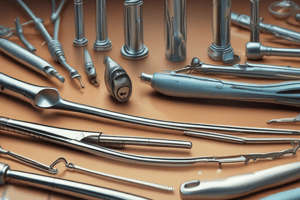Podcast
Questions and Answers
What is the essential prerequisite before sterilization of dental instruments?
What is the essential prerequisite before sterilization of dental instruments?
- Cleaning using a washer-disinfector
- Use of ultrasonic cleaning
- Manual cleaning (correct)
- Disinfection after sterilization
In the best-practice framework, when should manual cleaning of dental instruments be considered?
In the best-practice framework, when should manual cleaning of dental instruments be considered?
- If local experience indicates pre-washing helps (correct)
- Only when the manufacturer specifies automated cleaning
- After sterilization
- When washer-disinfector is available
What action may be appropriate before automated cleaning of dental instruments?
What action may be appropriate before automated cleaning of dental instruments?
- Sterilization
- Use of ultrasonic cleaning
- Pre-washing (correct)
- Disinfection
When should new dental instruments be cleaned and sterilized?
When should new dental instruments be cleaned and sterilized?
Why is it recommended to clean instruments as soon as possible after use?
Why is it recommended to clean instruments as soon as possible after use?
Which method is preferred for cleaning dental instruments whenever possible?
Which method is preferred for cleaning dental instruments whenever possible?
Why should long periods of wet storage be avoided when working with substances that can harden on instruments?
Why should long periods of wet storage be avoided when working with substances that can harden on instruments?
Why should instruments that cannot be cleaned immediately when working with substances that can harden (e.g., cements) be discarded?
Why should instruments that cannot be cleaned immediately when working with substances that can harden (e.g., cements) be discarded?
Why is manual cleaning considered when manufacturers’ instructions specify that a device is not compatible with automated processes?
Why is manual cleaning considered when manufacturers’ instructions specify that a device is not compatible with automated processes?
Why is validation important in the cleaning procedures of dental instruments?
Why is validation important in the cleaning procedures of dental instruments?
Which method is recommended for cleaning dental instruments due to its ability to reduce bioburden on reprocessed devices?
Which method is recommended for cleaning dental instruments due to its ability to reduce bioburden on reprocessed devices?
What is a requirement for washer-disinfectors when fitting and plumbing them for automated cleaning processes?
What is a requirement for washer-disinfectors when fitting and plumbing them for automated cleaning processes?
Flashcards are hidden until you start studying
Study Notes
Cleaning Methods
- Three principal methods of cleaning reusable dental instruments: washer-disinfector, manual combined with ultrasonic cleaning, and manual cleaning
- Effective cleaning is essential before sterilization to reduce the risk of transmission of infectious agents
Automated Cleaning
- Washer-disinfectors are preferred over manual cleaning as they include a disinfection stage that renders instruments safe for handling and inspection
- Automated cleaning should be used whenever possible, and manual cleaning considered only when the manufacturer specifies incompatibility with automated processes or when the washer-disinfector is unavailable
Manual Cleaning
- Manual cleaning is acceptable within the essential-quality-requirements framework, but should be governed by an appropriate protocol
- Manual cleaning may be necessary for instruments not compatible with automated processes or when the washer-disinfector is unavailable
Pre-Treatment
- Pre-washing may be helpful in removing tenacious dental materials, but should be done before automated cleaning
- Instruments should be cleaned as soon as possible after use to aid subsequent decontamination
- Water immersion, foam spray, or gel can help maintain a moist or humid environment, but long periods of wet storage should be avoided
Special Considerations
- Instruments with substances that can harden on them (e.g. cements) should be cleaned immediately
- Instruments that cannot be cleaned should be discarded
- Instruments and equipment with multiple components should be dismantled for cleaning, and dental team members should be trained in dismantling, cleaning, sterilizing, and reassembling instruments
General Requirements
- Manufacturers' instructions should be referred to when available
- Automated and validated processes should be used whenever possible
- Ensure instruments can be cleaned using a method available to the practice
- Validation is necessary to ensure reproducible and reliable cleaning, and technical details for validation standards and procedures can be found in Section 3
Automated Cleaning: Washer-Disinfectors
- Washer-disinfectors must comply with the Water Supply (Water Fittings) Regulations 1999
- Each stage of the decontamination process should contribute to the reduction of bioburden on the device being reprocessed
- Washer-disinfectors are the preferred method for cleaning dental instruments due to their inclusion of a disinfection stage
Studying That Suits You
Use AI to generate personalized quizzes and flashcards to suit your learning preferences.




